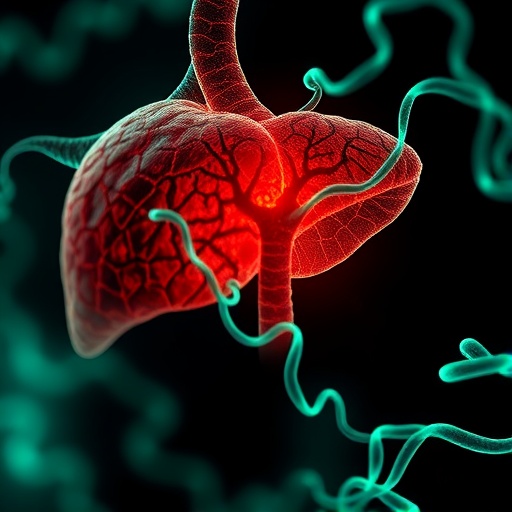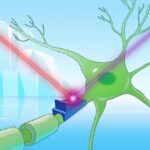
In a groundbreaking study poised to reshape our understanding of liver cancer metastasis, researchers have unveiled the pivotal role of the protein S100A4 in transforming non-metastatic hepatocellular carcinoma (HCC) cells into highly invasive and metastatic variants. This transformative process is intricately driven by the binding of S100A4 to non-muscle myosin IIA (NMIIA), uncovering a novel molecular axis that mediates cancer progression through intricate epithelial-mesenchymal transition (EMT) mechanisms.
Hepatocellular carcinoma stands as one of the most lethal malignancies worldwide, marked by aggressive progression and a notorious proclivity for metastasis. Despite advances in treatment, the prognosis for advanced-stage HCC patients remains grim, largely due to our incomplete understanding of the molecular pathways that govern metastatic dissemination. The research team, analyzing comprehensive data from The Cancer Genome Atlas (TCGA) alongside clinical liver cancer specimens, identified an alarming pattern: elevated S100A4 expression correlates with more aggressive tumor stages and lymphatic spread, highlighting its central role in exacerbating disease severity.
Diving deeper, the researchers engineered HCC cell lines to stably overexpress S100A4, enabling a systematic examination of its cellular effects. Cells genetically modified to produce high levels of S100A4 displayed pronounced migratory and invasive behaviors in vitro, as demonstrated by wound healing and Transwell invasion assays. These phenotypic changes signal a crucial shift in cellular dynamics, indicative of EMT—a process where epithelial cells lose their adhesive properties and acquire mesenchymal characteristics, thereby facilitating tissue invasion and metastasis.
.adsslot_ywX5tgQRcO{width:728px !important;height:90px !important;}
@media(max-width:1199px){ .adsslot_ywX5tgQRcO{width:468px !important;height:60px !important;}
}
@media(max-width:767px){ .adsslot_ywX5tgQRcO{width:320px !important;height:50px !important;}
}
ADVERTISEMENT
The study further illuminated the sophisticated crosstalk mediated via exosomes, nanoscale extracellular vesicles that orchestrate intercellular communication within the tumor microenvironment. Exosomes secreted by S100A4-high HCC cells were enriched with S100A4 protein, and their uptake by adjacent non-metastatic HCC cells significantly boosted the latter’s migratory and invasive capacities. This exosome-mediated propagation of metastatic traits underscores an underappreciated pathway by which aggressive cancer cells recruit and transform their less malignant neighbors, fueling tumor heterogeneity and expansion.
At the molecular level, the conspicuous downregulation of E-cadherin—an epithelial marker essential for cell-cell adhesion—alongside the upregulation of mesenchymal markers such as Twist1, N-cadherin, and Vimentin, points to a hallmark EMT switch driven by S100A4 overexpression. This reprogramming of gene expression profiles effectively dismantles cellular barriers, liberating cancer cells to disseminate throughout the body. Crucially, this process hinges on S100A4’s physical interaction with NMIIA, a cytoskeletal motor protein implicated in cellular contractility and motility.
Utilizing sophisticated protein interaction assays, the investigators demonstrated that S100A4 binds directly to NMIIA, forming a complex that orchestrates downstream molecular changes essential for EMT induction. Silencing NMIIA expression effectively blunted the EMT-associated changes induced by S100A4, incapacitating the migratory and invasive prowess of HCC cells. This discovery spotlights NMIIA as not just a structural component but a functional collaborator in metastasis, opening new vistas for therapeutic targeting.
The implications of these findings extend far beyond academic curiosity. By establishing S100A4 as a master regulator of EMT and metastasis in HCC, the study elevates this protein as a highly promising biomarker for predicting disease progression and patient prognosis. Its elevated presence in tumor-derived exosomes also raises the potential for non-invasive liquid biopsy approaches, enabling early detection and real-time monitoring of metastatic risk.
Furthermore, the elucidation of the S100A4-NMIIA axis provides an attractive molecular target for novel interventions. Therapeutic strategies aimed at disrupting this interaction or modulating S100A4 expression could inhibit EMT initiation, stymying metastatic spread and improving survival outcomes. This paradigm shift pivots on attacking the metastatic machinery at its molecular core, rather than merely addressing tumor growth.
The robustness of the study stems from its integrative approach, combining large-scale genomic analyses with meticulous mechanistic experiments. The consistency between patient-derived data and cellular models strengthens the translational relevance of the findings, ensuring that insights resonate within clinical oncology frameworks. Importantly, the study elucidates the contribution of exosome-mediated signaling, emphasizing the complex tumor microenvironment interactions that enable metastasis.
Given the pressing global burden of HCC, these revelations inject renewed optimism into the quest for more effective diagnostic and therapeutic strategies. Future research is poised to explore the therapeutic modulation of S100A4 and NMIIA, assess their roles across heterogeneous tumor landscapes, and unravel their interactions with other metastasis-related pathways. A nuanced understanding of how these proteins coordinate EMT and cellular dissemination will be instrumental in crafting precision medicine approaches.
In conclusion, the study compellingly positions S100A4 as a critical driver of metastatic transformation in liver cancer, acting through NMIIA binding to orchestrate EMT and enhance tumor invasiveness. This signaling nexus, amplified via exosomes, not only advances our grasp of HCC biology but also charts a course toward innovative biomarkers and therapeutic targets. As research unfolds, targeting the S100A4-NMIIA axis holds promise to transform the clinical management of hepatocellular carcinoma, potentially reducing metastasis and improving patient survival.
Subject of Research: The study investigates the role of the metastasis-associated protein S100A4 in promoting metastatic transformation and epithelial-mesenchymal transition (EMT) in hepatocellular carcinoma (HCC) through its interaction with non-muscle myosin IIA (NMIIA) and exosome-mediated signaling.
Article Title: S100a4 promotes metastatic transformation in non-metastatic liver cancer cells through NMIIa binding: mechanistic insights
Article References:
Qin, Y., Wang, C., Xu, S. et al. S100a4 promotes metastatic transformation in non-metastatic liver cancer cells through NMIIa binding: mechanistic insights. BMC Cancer 25, 1144 (2025). https://doi.org/10.1186/s12885-025-14502-4
Image Credits: Scienmag.com
DOI: https://doi.org/10.1186/s12885-025-14502-4
Tags: advanced-stage hepatocellular carcinoma prognosiscancer progression molecular pathwayselevated S100A4 expression and tumor aggressionepithelial-mesenchymal transition in HCCgenetic modification in cancer researchhepatocellular carcinoma metastasis mechanismsinvasive behavior of HCC cellslymphatic spread in liver cancernon-muscle myosin IIA role in cancerS100A4 and liver cancer metastasistargeted therapies for liver cancer metastasisThe Cancer Genome Atlas findings



